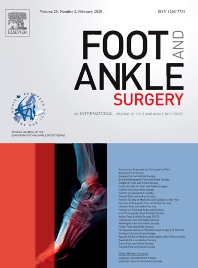
Pain relief, but no change in function or quality of life with dynamic splinting for hallux valgus
This report has been verified
by one or more authors of the
original publication.
Foot Ankle Surg. 2020 Feb;26(2):146-150.
Seventy patients with symptomatic hallux valgus were randomized to receive a dynamic splint or no treatment. The primary outcome of interest was the hallux valgus angle. Additional outcomes of interest included the intermetatarsal angle, range of motion, patient-reported clinical outcomes (American Orthopaedic Foot and Ankle Society Score; Foot and Ankle Outcome Score), pain scores, quality of life measures, and patient perceived change in symptoms, position and actual pain. Results revealed no significant difference in hallux valgus angle between the dynamic splinting and control groups. Pain scores at rest and the patient-perceived change in symptoms and position were significantly in favour of the dynamic splinting group. Significant differences in the pain and activities of daily living sub-scores on the FAOS were observed. Otherwise, no significant differences in clinical or radiological outcomes were observed.
Unlock the full ACE Report
You have access to {0} free articles per month.Click below to unlock and view this {1}
Unlock NowCritical appraisals of the latest, high-impact randomized controlled trials and systematic reviews in orthopaedics
Access to OrthoEvidence podcast content, including collaborations with the Journal of Bone and Joint Surgery, interviews with internationally recognized surgeons, and roundtable discussions on orthopaedic news and topics
Subscription to The Pulse, a twice-weekly evidence-based newsletter designed to help you make better clinical decisions
Exclusive access to original content articles, including in-house systematic reviews, and articles on health research methods and hot orthopaedic topics
Or upgrade today and gain access to all OrthoEvidence content for just $1.99 per week.
Already have an account? Log in


Subscribe to "The Pulse"
Evidence-Based Orthopaedics direct to your inbox.
{0} of {1} free articles
Become an OrthoEvidence Premium Member. Expand your perspective with high-quality evidence.
Upgrade Now













































































